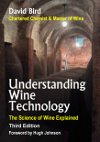Understanding Wine Technology, David Bird
| Title of book: | Understanding Wine Technology |
| Author: | David Bird |
| Publisher: | DBQA Publishing |
| Publication date: | 2010 |
| ISBN | 978-0-9535802-2-4 |
| Pages: | 307 |
| Price: | £25.00 |
 Over the past decade since this book was first published it has become a must-have information and reference tool for anyone interested in how wine is made.
Over the past decade since this book was first published it has become a must-have information and reference tool for anyone interested in how wine is made.
This third edition is more than one-third bigger than the first. New things since last time include, for example, histamine and allergens, green harvest, flash détente, an expanded section on variants of carbonic maceration, esters, mannoproteins and reductive taint. If you’re unsure of what any of these, and other things, mean, the explanations are all there.
Indeed the book sets out its stall to explain the science of winemaking for non-scientists, and this it has always achieved extremely well.
As with all wine quality, it starts in the vineyard, taking the reader, step by step, through the production process and options. With winemaking there is no one recipe, or formula. Many different options exist depending on what the winemaker might be trying to achieve, so for example, whether to remove the juice from the grapes by using a basket press, batch screw press, open or closed bladder press, or a continuous screw press, is an important decision. Bird describes all these pieces of kit (and so many others), as well as pointing out the main benefits and drawbacks of each.
Who knows (apart from readers of the previous edition) what pH actually stands for? The revised EU limits for total sulphur dioxide are tabulated, and the new EU legislation is all in here – 1493/1999 replaced by 479/2008, which has brought in PDO and PGI for wine, bringing it in line with other foods.
Despite the sometimes dry nature of the subject matter, the book is down to earth and readily approachable, and it’s sprinkled with sometimes droll, personal observations. One might not ordinarily expect an explanation of wine technology to contain phrases such as “Equally delicious … “, or “Once the exam has been passed, poetry can develop”, but this is Bird’s way of reminding the reader that, despite its sometimes technical mode of production, wine is all about taste, flavour and pleasure.
I would have liked to have seen included in the fortified section at least a nod to the production method of Australia’s iconic Rutherglen muscats; maybe an entry for such things as pyrazines and thiols. But perhaps some of these are still too esoteric for the mainstream. It’s a small detail, and I’m nit-picking.
This remains a thoroughly stalwart volume for the bookshelf.



